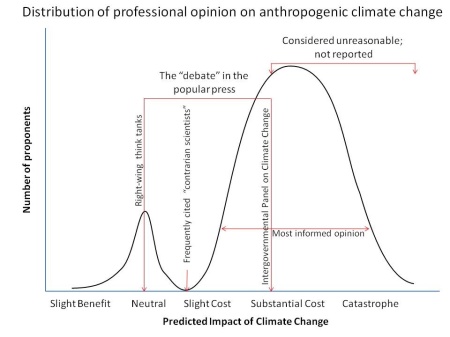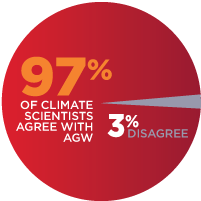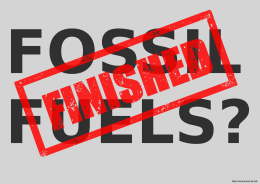False balance – cultivating counterfeit controversy to create confusion
| In science, talk of airing ‘both sides’ of an argument is usually a red flag. |
How to recognise this tactic
This tactic is promoted by peddlers of bad science and pseudoscience and is often taken up by journalists and politicians. In discussing an issue, they insist that “both sides” be presented. Many journalists routinely look for a representative of each “side” to include in their stories, even though it might be inappropriate. Groups or individuals who are pushing nonsense or marginal ideas like to exploit this tendency so that their point of view gains undeserved publicity.
… the journalistic norm of balance has no corollary in the world of science. On the contrary, scientific theories and interpretations survive or perish depending upon whether they’re published in highly competitive journals that practice strict quality control, whether the results upon which they’re based can be replicated by other scientists, and ultimately whether they win over scientific peers. When consensus builds, it is based on repeated testing and retesting of an idea.
Chris Mooney, American science journalist, 2004
Why do people use this tactic?
People use this tactic when they are promoting an argument that has little supporting evidence. They aim to gain publicity for their argument and to create the impression that its status is comparable to that of accepted models. This is usually because they believe that their existing position is threatened by the accepted science, and their ultimate aim is to sow doubt and confusion around the issue so that they are protected. The tactic exploits the vulnerabilities of journalists and politicians, many of whom follow the maxim that they must not show bias, and try to demonstrate this by giving opposing points of view equal consideration.
What’s wrong with this tactic
This tactic is not wrong in itself, but the context in which is applied often is. The notion of opposing “sides” maybe useful with political issues, but it very rarely fits science. Nearly always in science, the evidence clearly supports a particular model, and this is the one accepted by a large majority of experts in the relevant field, with only a handful of dissenters. When “both sides” are given equal exposure, it conveys the idea that both are equally worthy of consideration and so creates the impression that scientists are divided on the issue. There are often unresolved scientific issues, but to portray the situation as a black-or-white struggle is not realistic. Even when there are real controversies in science, it’s usually because there is insufficient evidence to decide either way. Scientists from both “sides” will admit this, rather than combatively insisting that the opposing model is unacceptable.
Many people believe that journalists resort to false balance because very few of them are scientifically literate, and they naively believe they are being fair. Others are less charitable. As Natasha Loder commented in a blog post for The Economist:
I think the motivations are far more trivial. Balance is easy and cheap. In political journalism, a vitriolic quote from each side and a punchy headline is all that is needed to feed the news machine. Who cares if substance and analysis are thrown to the wind?
What to do when confronted by this tactic
Understanding Science, produced by the University of California at Berkeley, points out that there are two valid types of scientific controversy – disputes over the basic ideas of fundamental models, or arguments over secondary aspects such as mechanisms. These can be settled only by gathering evidence. Conflicts around the periphery of science, such as those involving ethics of scientific methods or applications of scientific knowledge are not true scientific controversies – they involve political and social dimensions, and in debating these cases journalistic balance may be appropriate.
When investigating a purported debate, you need to first decide whether it’s about a true scientific controversy. If so, try to find out whether there’s a consensus view (and you can usually trust Wikipedia here). If there’s not, you’ll find that reputable scientists will be up-front about it. If it appears that a real potential for debate exists, don’t accept the arguments of the proponents unless there is supporting evidence. Investigate the field of expertise of each spokesperson. Those promoting the “oppressed” side often have no expertise in the field and/or no peer-reviewed papers on the topic. They prefer to carry on their debate in the media. If this is the case, you can safely ignore their opinions. Ultimately, if scientists are really divided on the issue, it’s a matter of waiting for sufficient evidence to arrive to tip the scales.
Variations and related tactics
This tactic is also known as the false equivalence fallacy or pseudosymmetry. It is sometimes used in conjunction with the tactic known as the argument to moderation, in which you are encouraged to take up a “balanced” position which is midway between the two extremes in a debate.
Examples
- Here’s a schematic illustrating how the typical journalistic balance on scientific issues can misrepresent the scientific consensus. The diagram refers to scientific opinion on the consequences of climate change, and comes from Michael Tobis at Only In It For The Gold.
- The climate change “debate” has been the catalyst for a proliferation of false balance in the media. PBS Newshour in the US recently broadcast a monumental example when it used blogger and climate denier Anthony Watts to “balance” converted climate skeptic Richard Muller. The details are at MediaMatters, here.
Update 2014/05/14: John Oliver, on Last Week Tonight, shows how these debates should be handled:
- Andy Lewis at The Quackometer, reveals a shocking case of false balance at the BBC in a program about the health effects of electromagnetic radiation. He also explores the harm that can result from such irresponsible reporting.
- Anti-vaccination campaigners have revelled in the exposure they have received from falsely-balanced media reports. The ABC’s Media Watch recently aired a classic case by WIN TV, in which the anti-science and non-expert Meryl Dorey was “balanced” against reputable health authorities. ScienceOrNot? pointed out just a few months earlier that one of the ABC’s own programs was just as guilty.
- Update 2013/04/15: Also on the anti-vaccination front, at least one newspaper continues to “balance” vaccination stories with the views of Andrew Wakefield, the guru of the anti-vaccination movement, long after he has been totally discredited. Science-Based Pharmacy has the story here.
- Creationists constantly insist that “both sides” of the evolution-intelligent design “controversy” should be taught in science classes. As Richard Dawkins and Jerry Coyne point out (here), a scientific controversy on the issue does not exist. Evolution is a scientific model, intelligent design is not a scientific model, but a religious one, a conclusion supported by the Kitzmiller v. Dover Area School District case in the US.
- Update 2014/02/17: Graham Readfearn has a wonderfully sarcastic look at the media’s thirst for false balance. He supplies a whole collection of “cut and past qualifiers for science stories.” For example:
Despite evidence that massive oil slicks can be damaging to birds, some sceptics believe the birds have doused themselves in crude through choice as they go through a dark and introspective “Emo” phase.
- Update 2014/08/28: Michael Specter has written a great article for The New Yorker that should be a beacon for all science journalists. It demonstrates how you can write an intelligent piece without succumbing to false balance. And Faye Flam explains why the article is so good at KSJ Tracker.
Further reading
The Substantial Costs and Minimal Benefits of False Balance by Matt Shipman at SciLogs.
Chris Mooney’s quote is from Blinded By Science: How ‘Balanced’ Coverage Lets the Scientific Fringe Hijack Reality, Columbia Journalism Review, Nov/Dec 2004, Vol. 43, Issue 4
| This is one of ScienceOrNot’s Science red flags. See them all here. |
Trackbacks & Pingbacks
- The bad science checklist of GMO opponents
- “Seek Truth and Report It” | Keeping Up With Communication and Media Studies
- Alistair Wardrope: ‘One go-to contrarian economist dissents over key climate impact report…’ | Medact
- The Balance Fallacy: Where ignorance and lies gets promoted as knowledge
- False Balance about Vaccines – Vaxopedia
- Science Red Flags – autisticagainstantivaxxers
- What Is the One Conversation Vaccine Event? – VAXOPEDIA











Great post. Reminded me of this cartoon
Thanks Peter. Good examples in that cartoon.
Great post! I would add that, although there may be no real corollary pertaining to the idea of balance between journalists and the world of science, a scientist (or organization) can influence opinion by communicating the science in ways that make sense to people without scientific training. Heading off the “controversy” before it has a chance to take hold.
It just takes a little work to determine what ideas the intended audience is pre-disposed to and shaping scientific messages in this way.
Thanks Justin. I wish I could agree with your optimism regarding communicating the ideas simply. Unfortunately, I think individuals and organisations promoting a pseudoscientific agenda are also adept at making their arguments sound like simple common sense (witness the ‘global warming stopped x years ago’ ploy), Ultimately, it comes down to those reporting the issues to dig behind the simple explanations and find what supporting evidence exists.